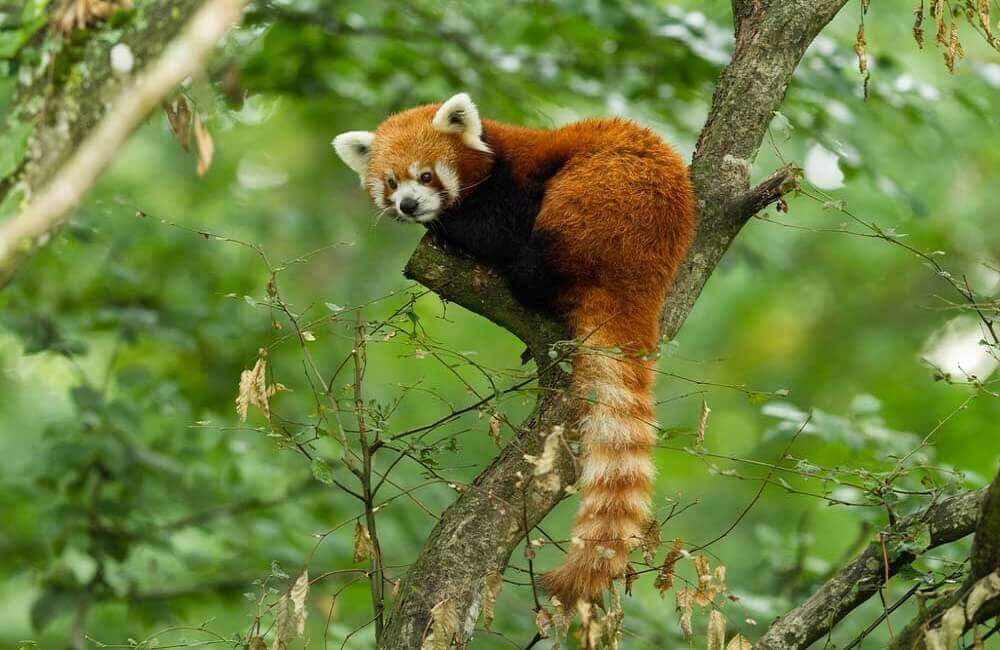
The red panda belongs to the family Ailuridae, genus Ailurus and class Mammalia. This charming arboreal is highly admired for its reddish-brown fur, large fluffy ringed tail, waddling gait due to shorter front legs and decorative coat marked handsomely in russet, black and white. Although it shares its name with the black-and-white giant panda, they are not closely related. The red panda is a solitary animal and is mostly sedentary throughout the day. Owing to their expressive faces and interesting body aspects they are very popular in native Asia as toys and mascots and it’s due to this very reason the red pandas are endangered. In this article, we will learn why red pandas are endangered and the threats faced by them.
Where Do Red Pandas Live?
The red panda is native to the temperate forests of the Himalayas ranging from the foothills of western Nepal, stretching through Myanmar (Burma), and extending up to China in the East. From southern Tibet, Sikkim, and Assam in India, Bhutan, the northern mountains of Burma to south-western China extends the natural habitat of the panda. The red panda prefers high altitude (7,200 ft. to 15,700 ft.), moderate temperatures, mountainous mixed deciduous and conifer forests with old trees, and dense bamboo growth.
What Do Red Pandas Eat?
Red pandas feed mainly on bamboo leaves and shoots. In fact, they have a special wrist bone projection to help grip bamboo shoots. Their diet also includes eggs, birds, insects, mushrooms, leaves and berries, small birds, and rodents. Their metabolism is slow due to the poor nutritional value of bamboo.
Are Red Pandas Endangered?
In 2015, the status of the red panda was dropped from ‘vulnerable’ to ‘endangered’ on the International Union for the Conservation of Nature’s Red List of threatened species. As of now, its global population is estimated at about just 10,000 mature individuals and is on a continuous decline. It has been estimated that their population has decreased by as much as 40 percent over the last 50 years due to several reasons such as habitat loss, poaching, and human encroachment.
In China itself, a 40 percent decrease in the population of red panda has been recorded in the last 50 years while population density in the western Himalayas has dropped even lower. Today, they are found only in small, isolated groups in a few regions of China and the south-western Himalayas. Its population has decreased to such an extent that it currently resides in only half of the total area of potential habitat which is 142,000 square meters.
Why Are Red Pandas Endangered?

One of the most adorable and popular creatures on this planet is on the verge of extinction primarily due to the negligence and greed of humans. The other contributing factors include major habitat destruction due to farming, deforestation, logging of firewood, rampant forest fires, prey depletion, and inbreeding. Each of these factors is of relative importance in their respective regions. Below we have elaborately discussed various threats to the red panda:
1. Habitat Loss:
Red pandas mainly inhabit the temperate forests of Eastern Himalayas which are being cut down at an alarming rate for logging operations or to convert them into farmland for crop cultivation and cattle grazing. Due to acute deforestation, red pandas are forced to leave their habitat for cover. This worsens their natural population subdivision by geography, topology, and ecology leading to severe fragmentation of the wild population. As the pandas are forced to leave their habitat and move to another shelter they become more vulnerable to hunting and poaching. Also, they have to find food sources in newer areas.
Additionally, habitat degradation also causes the pandas to separate from each other i.e. their population is becoming scattered and isolated. Due to lack of groups, external mating becomes almost impossible and inbreeding comes in the picture. The offspring produced due to inbreeding is weak, susceptible to diseases, and has a high death rate and low fertility. Inbreeding results in decreased genetic variation which is also one of the major reasons for species extinction. Also, a naturally low birth rate and a high death rate of the red panda is an added issue.
2. Poaching And Hunting:
Red pandas are native to southwestern China. Sadly, there they are illegally hunted for their bright, reddish fur, particularly the highly prized striped bushy tails, from which hats are made. They are also hunted for their pelts which is made into fur capes and can be found in many local markets of China. Their hide is also coveted as it is traditionally believed to bring good luck upon newlywed couples and is carried by them at the weddings. The hats are also considered good luck charms and are worn by people on special occasions. Despite this tradition being declared illegal, it is still practiced by many. The practice comes from the age-old belief as red pandas are depicted in a hunting scene of a 13th-century Chinese pen-and-ink scroll. Black markets are also rife with traditional, Asian medicines made from different parts of the panda, which again, is illegal.
3. Keeping As Pets:
In many parts of India and Nepal, red pandas are illegally trapped to be kept as pets. Being really appealing and cute they are in high demand as pets, This illegal practice had a destructive effect on the population of the pandas as they are not domestic animals. Unable to bear the stress of captivity they become fearful and aggressive of their owners.
Red pandas are also captured and sold to the zoos where they are held in captivity forever. An article appearing in the International Zoo News quoted a trainer personally handling 350 red pandas in 17 years. However, due to growing awareness, captivity in zoos has decreased significantly but poaching of red pandas and selling them to private collectors for high prices is still going on.
4. Accidental Trapping:
Local populations around the red panda’s habitat harm them in many ways. Apart from hunting the pandas for money, they accidentally get them in traps meant for other animals. Many times, villagers, locals set large, strong, metal traps for predators like wolves and bears, in which unsuspecting red pandas are caught. Owing to their small size, trapped pandas get critically hurt and often fail to survive. Sometimes, they also fall in a snare- style traps meant for animals like wild pigs, deer, boars, and hares.
Additional Reasons- Climate Change And Development Projects:
Due to the climate change, the natural habitat of the panda in the Himalayas is warming up, forcing them to move to higher elevations and adapt to new habitat and lifestyle. In this process, many lose habitat faster than they accommodate to climate change.
Red panda feeds preferably on bamboos but recent studies suggest that global warming can cause bamboo species in lower altitudes of China to deplete, forcing the pandas to move from there. Thus, climate change intensifies the effects of habitat loss, loss of genetic diversity and physical threats. Also, due to the many development projects by humans, say, railway tracks laying, piping, plant construction, habitat is destroyed.
Red pandas may not be as famous as their worldwide popular counterpart, the giant panda, but they have distinctive characteristics that make them unique and appealing. It is really unfortunate and appalling that human actions have led to the endangerment of this species. However, the conservation effects by many organizations and governments in the form of forest conservation and strict legislation against deforestation, and poaching raise hope that the actions of few greedy men will not decide the future of this alluring mammal.
